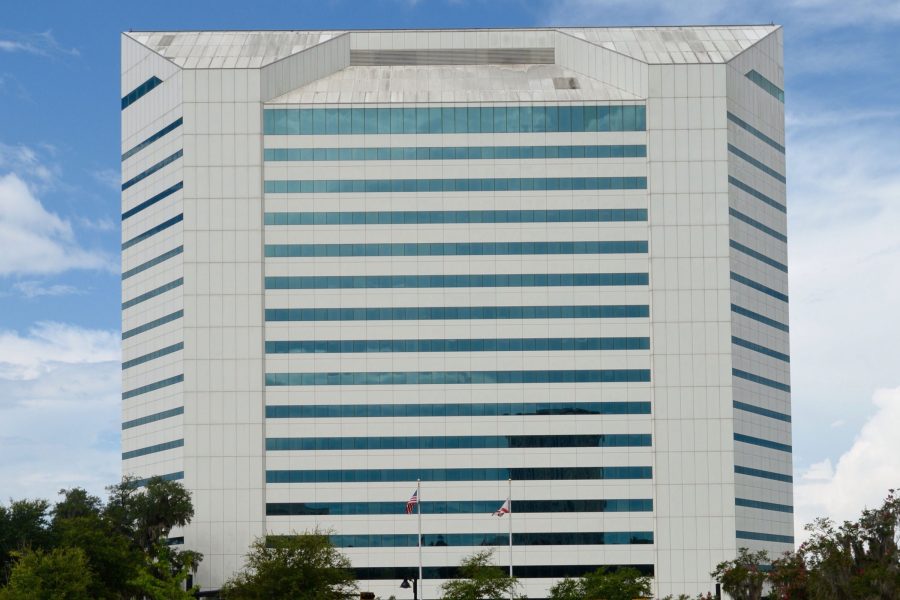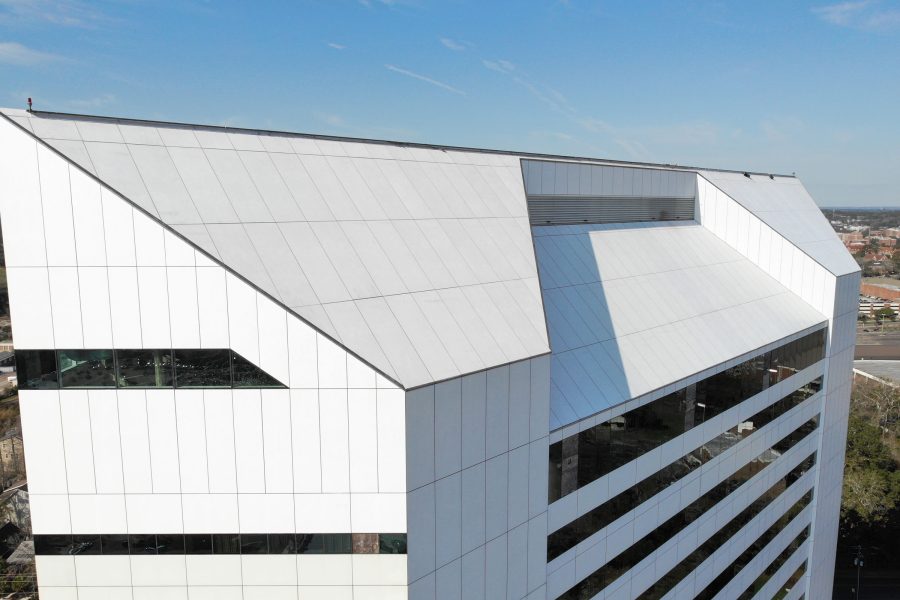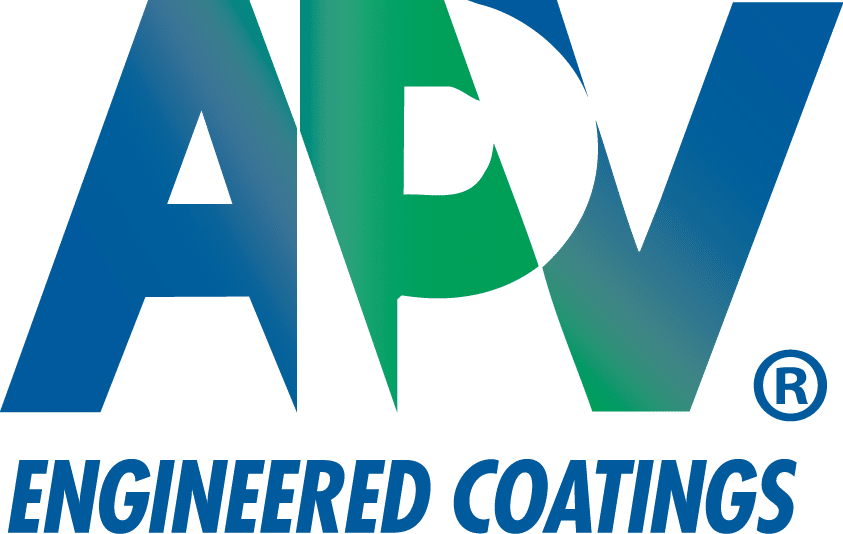Story at a glance:
- MLD Architects was faced with the task of restoring the Turlington Building to its original factory fresh-looking finish.
- A PVDF-based coating system made the challenging facade project in Florida easier to complete.
The Ralph D. Turlington Florida Education Center, commonly known as the Turlington Building, cuts a striking figure in the Tallahassee, Florida skyline. The iconic, multi-angled, 18-story structure features a highly pitched roofline that pierces upward in a strong, modernist architectural style.
Construction of the building, which houses the Florida Department of Education, was completed in 1989. Since that time the building’s aluminum and glass panel exterior lost its luster and regular cleaning of soot and dirt on the building’s facade proved to be unsustainable over the long term.
To help restore the Turlington Building to its original factory fresh-looking finish, its owners, the Department of Management Services (DMS), turned to MLD Architects of Tallahassee, Childers Construction Company, also of Tallahassee, and All Trades Historical Restoration of St. Petersburg, Florida. A full facade restoration, using NeverFade® Exterior Paints formulated with Kynar Aquatec® PVDF resin, began in December 2021 and was completed in May 2023, after pausing for three hurricanes.
Climate Takes its Toll

Years of exposure to the elements degraded the building’s appearance. Photo courtesy of MLD Architects
By 2015 the Turlington Building’s once bright-white exterior had become dull and muddled after decades of atmospheric pollution. All Trades Historical Restoration cleaned the exterior, and MLD Architects repaired leaks caused by unsealed joints between the building’s metal panels and glass windows.
Both of these facade repair and maintenance projects were successful, but several years later, windborne dust and grime, along with relentless UV exposure, continued to degrade the building’s appearance.
“The original factory coating on the metal panels was coming to the end of its lifespan,” says Iain Harnden, principal at MLD Architects. “While the coating still had good adhesion and wasn’t peeling, the clear topcoat had disintegrated, creating a textured surface that retained dirt.”
This time DMS decided to initiate a full-scale exterior restoration. The goal: a long-lasting finish that would stand up to the area’s unique environmental conditions. When evaluating exterior coating options, project managers discovered that while not all coatings were up to the task, one was: NeverFade Exterior Paints formulated with Kynar Aquatec PVDF resin.
“In subtropical climates like Tallahassee, buildings are regularly exposed to harsh UV rays, high heat and humidity, which can cause building exteriors to fade,” explains Ron Partridge, seniors account manager, fluoropolymer coatings, for Arkema. “Even high-performance paints can quickly chalk, fade and degrade. However, coating systems formulated with polyvinylidene fluoride (PVDF) resin technology deliver long-term colorfast performance other coatings can’t.”
Arkema’s Kynar Aquatec PVDF resin is a tough, engineered thermoplastic polymer that promotes excellent weatherability, color retention, and abrasion resistance thanks to carbon-fluorine bonds that do not break down under exposure to the elements. It has extreme weatherability like that of Kynar 500® PVDF resin-based coatings, which have been used in factory finishes on exterior building materials for six decades. Side-by-side southern Florida weathering testing of Kynar 500 and Kynar Aquatec based coatings over the past 23 years show similarly superlative performance with respect to color fade and chalking.
“I was familiar with solvent-based Kynar 500® technology and was pleasantly surprised to find the PVDF technology is also available for field applications,” Harnden says. “It can be difficult to find a field-applied coating system for metal panels that is so close to the original factory-applied finish.”
Kynar Aquatec PVDF resin helps APV Engineered Coatings’ field-applied water-based NeverFade Exterior Paints resist extreme UV rays, high temperature, humidity, and abrasion from salt spray, sand, and other windblown particles. It also hinders mold, mildew, and dirt pickup for more than 20 years—a much longer lifespan than the five-year life cycle typically seen with high-performance urethanes and acrylic latex paints used in climates such as Florida and Arizona. In environments like those, traditional high-performance paints break down under UV exposure, eroding over time and eventually leaving the building’s substrate bare and open to damage from the elements.
“NeverFade is ideal for resisting the dirt pickup that plagued the Turlington Building in the past—a key consideration for this white-colored building,” Harnden says.
Teamwork and Technology
To test the performance of various coatings, four coatings suppliers installed side-by-side mock-ups on the ground floor of the building. MLD Architects and Childers Construction Company worked closely with specialists from Arkema, APV Engineered Coatings, and distributor Lazer Manufacturing throughout the mock-up and subsequent installation process.
“Representatives from Lazer and Arkema showed our firm how well Kynar Aquatec based coating systems had fared on similar buildings throughout Florida,” Harnden says. “Because the Turlington Building project did not involve costly removal of the existing coating, the mock-up process was crucial to ensuring that the coating would adhere to the previously powder-coated surface.”
“The other coatings under consideration from other manufacturers failed tape adhesion testing,” says Randall Gardner, project manager at All Trades Historical Restoration. “They also lacked the smooth finish and uniformity of the Kynar Aquatec–based coating, which gives you a great end result.”
Harnden and Gardner say the choice of NeverFade Exterior Paints was solidified by its industry-leading 15-year product and labor warranty that covers fading, plus the fact that it is a one-component water-based air-dry system. Tallahassee’s high temperatures and humidity would have caused two-component systems to become tacky quickly, making them difficult to roll on and making application almost impossible. In addition, the water-based Kynar Aquatec based coating is low in volatile organic compounds, meaning building occupants and the painting crew would not be inconvenienced by nuisance odors.
Application Challenges Quickly Addressed

The angular structure posed challenges to the painting crew. Photo courtesy of MLD Architects
Because of the Turlington Building’s height, multiple faces, and 45-degree roof angle, it was challenging to paint. Two crew members manned swing stages hung from the roof, while a support crew member remained on the ground.
“The swing stages only reached the 16th floor of the 18-story building, so we had an additional crew of up to six rappelers on bosun chairs working on higher levels,” Gardner says. “Given these extreme conditions and the extreme sun and wind, we needed a coating formula that would be easy to apply via roller, at the appropriate film thickness and with a quick dry time, but not so quick that we couldn’t maintain uniform coverage across the panels. NeverFade Exterior Paints with Kynar Aquatec fit the bill perfectly.”
Gardner says his crew initially applied the coating in three drops across the large metal panels, working from left to right to maintain a wet edge. However, overlapped roller marks—a big challenge with rolling a coating onto a metal surface in high ambient temperatures—were visible from the ground, prompting the extended project team to brainstorm a way to install the coating in two drops and feather in the overlap lines for a seamless finish.
“The team from Arkema and APV was on-hand many times throughout the project, including each time we completed a face of the building,” Harnden says. “They got up on the swing stages to make sure the work was completed correctly, allowing us to avoid the significant cost of re-rigging swing stages to accommodate rework.”
In addition to the logistical challenges posed by the building’s height and roofline, the crew faced another challenge early in the restoration process. As Gardner’s crew began to pressure wash the building during the surface preparation stage, the dark, tacky caulking material between sealant joints in the roof panels was dislodged, creating unsightly streaks down the side of the building. Because coating over the streaks would void the warranty by compromising adhesion integrity, the project team hand sanded the residue off, wiped the surface down with alcohol to remove any traces, and resealed the roof before completing the coating application.
Proper preparation of the building substrate is crucial for good adhesion of the NeverFade paint. We needed to make sure that those panels were well sealed against water intrusion to eliminate the chance of sealant residue bleed out.
“Any time we had even the smallest issue, reps from Arkema, APV, and Lazer were there to help and check on the resolution—from recommending sander grit, checking our millage, and conducting scratch and adhesion tests, to final inspection,” Gardner says. “They were there every step of the way, making sure the coating was being applied properly.”
“All Trades and those involved were extremely pleased with the finished result and the support we received from Arkema and APV throughout the extended timeline of the project,” Gardner says, who also noted that his firm has generated new, high-profile business opportunities thanks to the success of the project. “We’re now using the Kynar Aquatec based coating on different surfaces like masonry, stucco, and roofing and are specifying it for just about every new project we bid on to help keep buildings looking clean and fresh for decades. It’s the best thing you can have on your building.”


